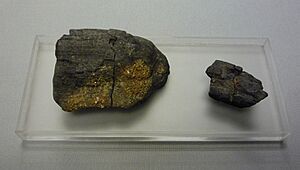Devil's Lair facts for kids
Quick facts for kids Devil's Lair |
|
|---|---|
| Location | Leeuwin-Naturaliste National Park, Western Australia |
| Geology | Karst cave |
| Registry | 6WI-61 |
Devil's Lair is a special cave in Western Australia. It's located inside the Leeuwin-Naturaliste National Park, about 5 kilometers (3 miles) from the coast. This cave is quite small, with a floor area of about 200 square meters (2,150 sq ft). It formed in limestone rock, which was once part of ancient sand dunes.
Scientists have found many layers of sandy dirt inside the cave, some as deep as 6.6 meters (22 feet). These layers hold clues about the past. They show that people lived in this cave a very long time ago. In fact, evidence suggests humans were here as far back as 50,000 years ago! This makes Devil's Lair one of the oldest known places where humans lived in Southwest Australia.
Contents
Exploring Devil's Lair: What Did We Find?
Since the 1970s, scientists called palaeontologists (who study ancient life) and archaeologists (who study human history) have been exploring Devil's Lair. They have carefully dug up many interesting things from the cave floor.
These discoveries include stone tools, lots of animal bones, old hearths (places where fires were made), and even human bones. Everything found here has been very well preserved. This means we have a clear and long record of how people lived and what the environment was like in this part of Australia.
The cave got its name because scientists found bones of the Sarcophilus harrisii, also known as the Tasmanian devil. These animals used to live in this area but are now only found in Tasmania. The earliest studies of animal bones in the cave were done in 1955. Later, a human tooth was found among kangaroo bones, which made scientists realize how important this site was for understanding human history.
Why Devil's Lair is So Important
Devil's Lair is a very significant place for understanding Australia's past. It's one of the earliest known sites where humans lived on the continent. It also has some of the oldest human ornaments ever found in Australia.
The cave gives us a rich look into the cultural and natural history of southwestern Western Australia. People lived here over 40,000 years ago, with some evidence suggesting human presence as early as 48,000 years ago. This discovery helps us understand how and when people first arrived in Australia.
The things found at Devil's Lair, like special scrapers, jewelry, fire pits, and animal remains, show us what life was like during the Late Pleistocene period. They also reveal how clever people were at making tools back then. Even though not many people lived in the cave, it helps us learn about how ancient people adapted to living on land, possibly moving away from coastal areas.
Ancient Tools and Technology
Scientists found both stone and bone tools in different parts of Devil's Lair. These tools were very useful and well-made for their time. They include sharp flakes of stone, bone points, and scraper tools.
The stone tools were made using a method where pieces were chipped off a larger stone core. Some stone flakes were used for cutting and sawing. Other tools, like quartz cores, were reused as scrapers. Bone points were also common. They were sharpened and used in ways similar to how Aboriginal people used bone tools more recently.
How We Know the Dates: Dating the Past
Scientists have used different methods to figure out how old the things found in Devil's Lair are. These methods show that people started living in the cave around 48,000 years ago. This makes Devil's Lair one of the oldest sites in Australia. It gives us important information about the first people who settled here.
Charcoal: Clues from Ancient Fires
One way to date the past is by using Carbon-14 dating on charcoal. Charcoal is what's left of wood after it burns. Scientists found charcoal fragments in Devil's Lair. Even though it was tricky because of the many unique plants in the area, they were able to identify the charcoal as reliable for dating.
By studying the charcoal, scientists learned about different times when people lived in the cave. There were three main periods of settlement:
- Around 24,000 to 17,000 years ago, during a dry climate with less plant life.
- Around 12,000 years ago, when the climate was wetter and there were more plants.
- Around 500 to 300 years ago, when the climate was similar to today.
The earliest dates, about 48,000 years ago, show the very first times people lived in Devil's Lair.
Human Remains: Direct Evidence
Scientists also found human bones and teeth in Devil's Lair. These remains give direct evidence of the people who lived there. A male hip-bone was found and dated to be about 12,000 years old. It was found near a fire pit, which might mean it was placed there on purpose.
Three human teeth were also discovered:
- A permanent front tooth, about 8,000 to 12,000 years old.
- A baby tooth, about 17,000 years old.
- A small child's tooth, about 19,000 years old.
These findings help us understand the age of the people who lived in the cave long ago.
Ornaments: Early Art and Symbols
Excavations at Devil's Lair also uncovered some of the earliest human ornaments in Australia. These include three beads made from animal bones. They are between 19,000 and 12,700 years old. These beads were made by cutting bone shafts into small pieces and then smoothing them.
Scientists also found a stone object with a hole in it, which might have been used as a pendant. This object is about 14,000 years old. These items are very important because they are some of the first signs of symbolic behavior in Australia. They help us understand when and how humans started to express themselves through art and symbols.
Images for kids



